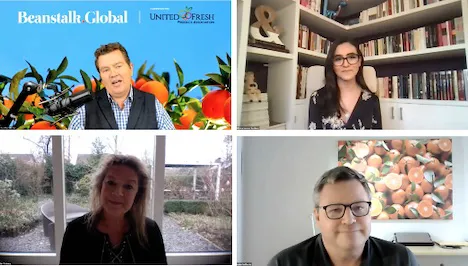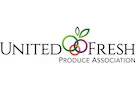This week’s BrandStorm event, organized by United Fresh, featured various webinars about marketing trends and strategies. One of the discussions on Wednesday looked at the global trends in marketing. This session was led by Max MacGillivray, who is editor-in-chief at Beanstalk.Global, and featured Marius Du Plessis of citrus company Clemengold International, based in South Africa, Alies Padding of packaging company NNZ Inc., based in the Netherlands, and Mónica Moreno of marketing agency Grupo PM, based in Mexico.

Top: Max MacGillivray and Mónica Moreno. Bottom: Alies Padding and Marius Du Plessis.
Branding in produce
Clemengold® has created multiple brands for their citrus products within the company, including LemonGold®, HoneyGold® and NavelGold®. Du Plessis explains the role branding plays in the company: “Our vision started in the Southern Hemisphere here in South Africa and we work with likeminded growers who have the same vision as us with regard to branding and realize that customers want to see a brand in the store for 12 months out of the year. So we have suppliers in Spain, Morocco, and even in competitor southern hemisphere countries. We have created a brand ecosystem and built upon this ecosystem with our partners.”
Clemengold has 4,500 employees in South Africa, and across their global partnerships they have a total of 15,000-20,000 employees; they have 130 customers spread out over 47 countries and 37 different ports. Despite this, the company’s brand remains the most important focus: “The biggest part of the job is the brand. A brand is a language, an identity, it is the way you speak to the customer. We spend a lot of time pushing the brand knowledge not just out onto the customer but also onto the people in our packhouses and orchards. This creates intuitive decision making as we market up and down to keep the brand strong.”
Branding in packaging
NNZ Inc. is based in the Netherlands and provides a wide variety of packaging solutions to the fresh produce industry across the world. Packaging helps to communicate branding to the customer and the consumer not only through the messaging that is printed onto the packaging but also through the style and material used for the packaging. “The changes in packaging and the drive for sustainable packaging has been ongoing for the past 4 to 5 years,” says Padding. “It has been politically driven, but it has also been driven by consumer perceptions.”
At NNZ, packaging is approached holistically. Padding explains: “We have a fact-based tool that examines the needs of the customer and their product and aligns them with our different options. What will be the packaging’s footprint? How will it help uphold shelf-life, thus preventing food waste? Most importantly, we take consumer insights into consideration. Our research has found that while many consumers value sustainability, there is still work to do on helping them understand sustainable packaging. When asked what the most sustainable packaging option would be, they often choose a cardboard option. In stores, however, they go for plastic punnets, because of the visibility of the product inside as well as the lower cost. So, it is very important to take these factors into consideration.”
Communication with the consumer
While many companies in the industry are shifting toward sustainable packaging, Moreno shares that it is very important to also communicate this shift to the consumer. “If you are doing sustainable packaging for your products and working on helping the environment, you have to tell that story. Consumers are no longer worried only about what they eat, but also about the story behind it, such as the packaging.” Padding adds: “Make it clear on the packaging itself how this purchase will help the consumer make sustainable decisions, such as the packaging using 22% less CO2 in its production.”
Communication with the customer and the consumer goes beyond packaging, too, Moreno says. “The first step to developing a strong brand is the find out what you want to communicate to your audience as well as narrowing down who exactly is in your audience. We need to understand what they are looking for and then communicate to them how exactly we are fulfilling their needs. Go beyond health – of course our products are healthy, so we need to go beyond that in our marketing. Tell them about the flavor, the story, and who is growing the fruit.” Du Plessis agrees: “Brands often try to tell consumers what we think – we are the experts, after all – but we need to listen to the customers more and practice humility. Make your brand fit with your customer, tailor it to them.”
Today is the last day of the BrandStorm event. To sign up to participate, click here.
 For more information:
For more information:
Mary Coppola
United Fresh Produce Association
Tel: +1 (202) 303-3425
Email: mcoppola@unitedfresh.org
www.unitedfresh.org
